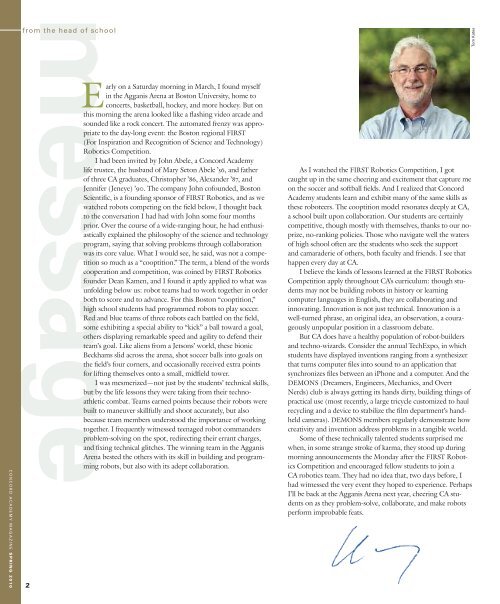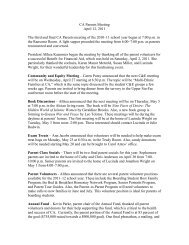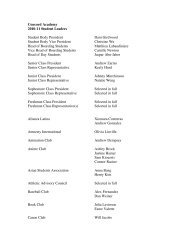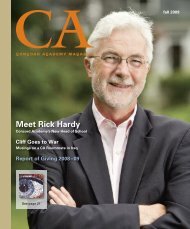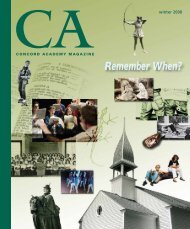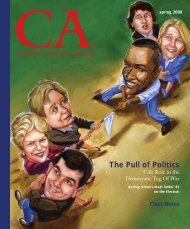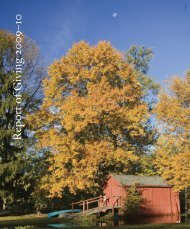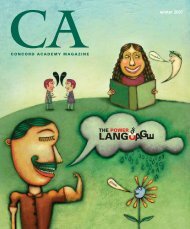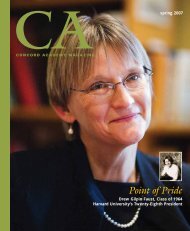Class Notes
S - Concord Academy
S - Concord Academy
- No tags were found...
Create successful ePaper yourself
Turn your PDF publications into a flip-book with our unique Google optimized e-Paper software.
C O N C O R D A C A D E M Y M A G A Z I N E S P R I N G 2 0 1 0messagefrom the head of school2Early on a Saturday morning in March, I found myselfin the Agganis Arena at Boston University, home toconcerts, basketball, hockey, and more hockey. But onthis morning the arena looked like a flashing video arcade andsounded like a rock concert. The automated frenzy was appropriateto the day-long event: the Boston regional FIRST(For Inspiration and Recognition of Science and Technology)Robotics Competition.I had been invited by John Abele, a Concord Academylife trustee, the husband of Mary Seton Abele ’56, and fatherof three CA graduates, Christopher ’86, Alexander ’87, andJennifer (Jeneye) ’90. The company John cofounded, BostonScientific, is a founding sponsor of FIRST Robotics, and as wewatched robots competing on the field below, I thought backto the conversation I had had with John some four monthsprior. Over the course of a wide-ranging hour, he had enthusiasticallyexplained the philosophy of the science and technologyprogram, saying that solving problems through collaborationwas its core value. What I would see, he said, was not a competitionso much as a “cooptition.” The term, a blend of the wordscooperation and competition, was coined by FIRST Roboticsfounder Dean Kamen, and I found it aptly applied to what wasunfolding below us: robot teams had to work together in orderboth to score and to advance. For this Boston “cooptition,”high school students had programmed robots to play soccer.Red and blue teams of three robots each battled on the field,some exhibiting a special ability to “kick” a ball toward a goal,others displaying remarkable speed and agility to defend theirteam’s goal. Like aliens from a Jetsons’ world, these bionicBeckhams slid across the arena, shot soccer balls into goals onthe field’s four corners, and occasionally received extra pointsfor lifting themselves onto a small, midfield tower.I was mesmerized—not just by the students’ technical skills,but by the life lessons they were taking from their technoathleticcombat. Teams earned points because their robots werebuilt to maneuver skillfully and shoot accurately, but alsobecause team members understood the importance of workingtogether. I frequently witnessed teenaged robot commandersproblem-solving on the spot, redirecting their errant charges,and fixing technical glitches. The winning team in the AgganisArena bested the others with its skill in building and programmingrobots, but also with its adept collaboration.As I watched the FIRST Robotics Competition, I gotcaught up in the same cheering and excitement that capture meon the soccer and softball fields. And I realized that ConcordAcademy students learn and exhibit many of the same skills asthese roboteers. The cooptition model resonates deeply at CA,a school built upon collaboration. Our students are certainlycompetitive, though mostly with themselves, thanks to our noprize,no-ranking policies. Those who navigate well the watersof high school often are the students who seek the supportand camaraderie of others, both faculty and friends. I see thathappen every day at CA.I believe the kinds of lessons learned at the FIRST RoboticsCompetition apply throughout CA’s curriculum: though studentsmay not be building robots in history or learningcomputer languages in English, they are collaborating andinnovating. Innovation is not just technical. Innovation is awell-turned phrase, an original idea, an observation, a courageouslyunpopular position in a classroom debate.But CA does have a healthy population of robot-buildersand techno-wizards. Consider the annual TechExpo, in whichstudents have displayed inventions ranging from a synthesizerthat turns computer files into sound to an application thatsynchronizes files between an iPhone and a computer. And theDEMONS (Dreamers, Engineers, Mechanics, and OvertNerds) club is always getting its hands dirty, building things ofpractical use (most recently, a large tricycle customized to haulrecycling and a device to stabilize the film department’s handheldcameras). DEMONS members regularly demonstrate howcreativity and invention address problems in a tangible world.Some of these technically talented students surprised mewhen, in some strange stroke of karma, they stood up duringmorning announcements the Monday after the FIRST RoboticsCompetition and encouraged fellow students to join aCA robotics team. They had no idea that, two days before, Ihad witnessed the very event they hoped to experience. PerhapsI’ll be back at the Agganis Arena next year, cheering CA studentson as they problem-solve, collaborate, and make robotsperform improbable feats.Tom Kates


